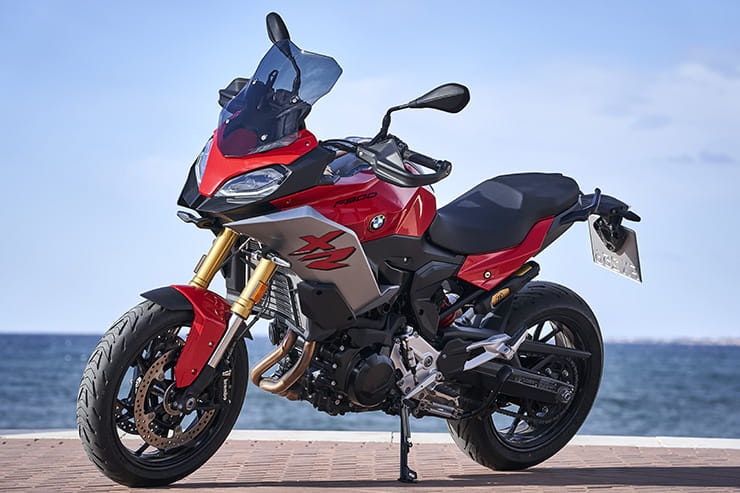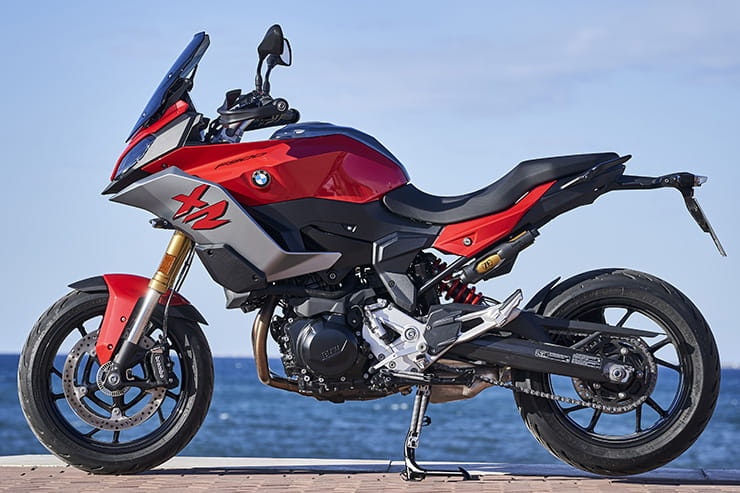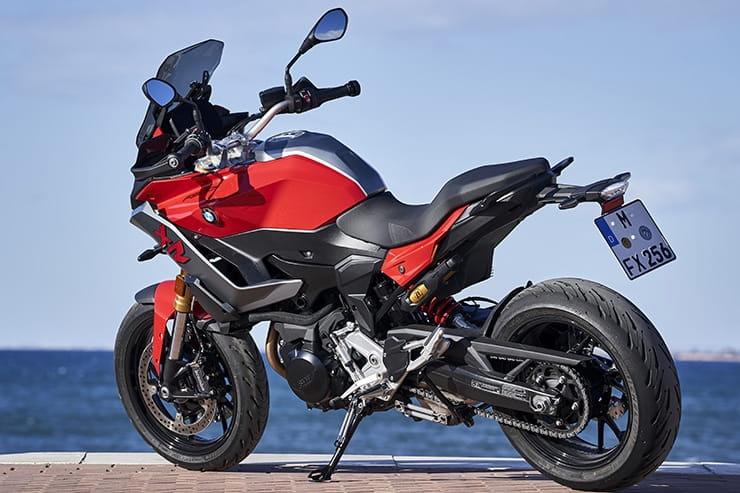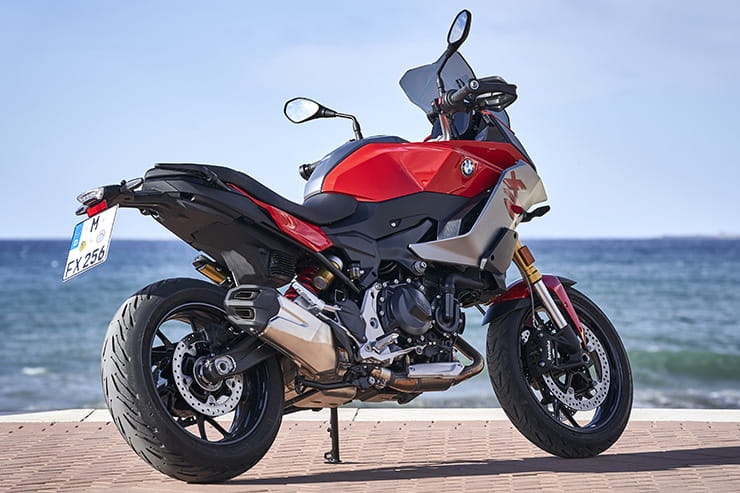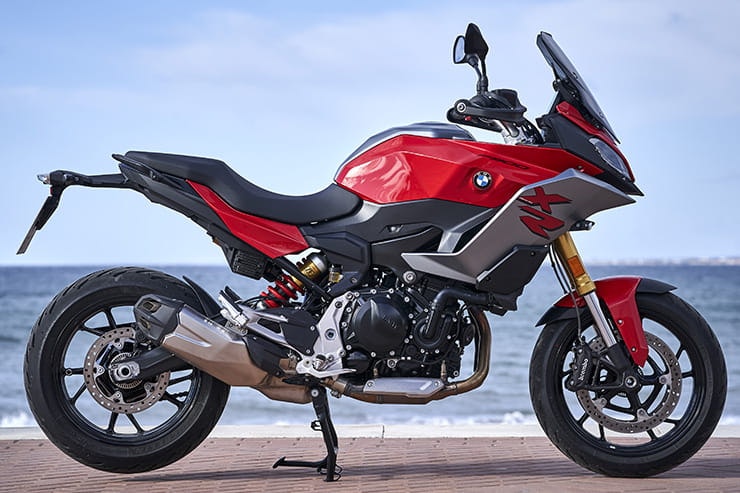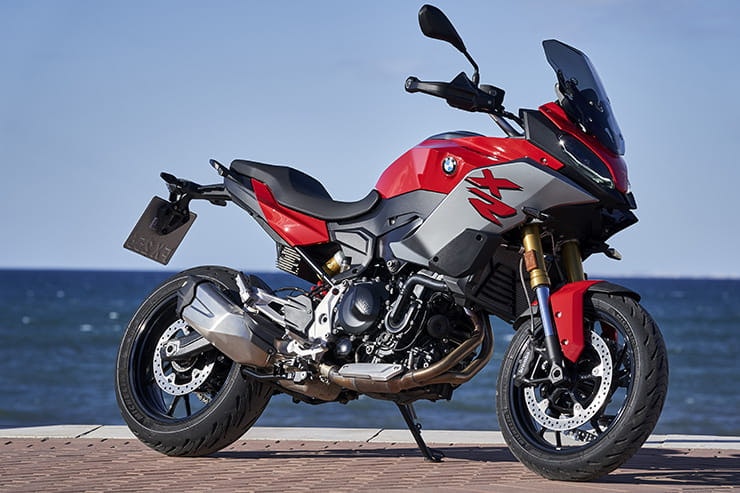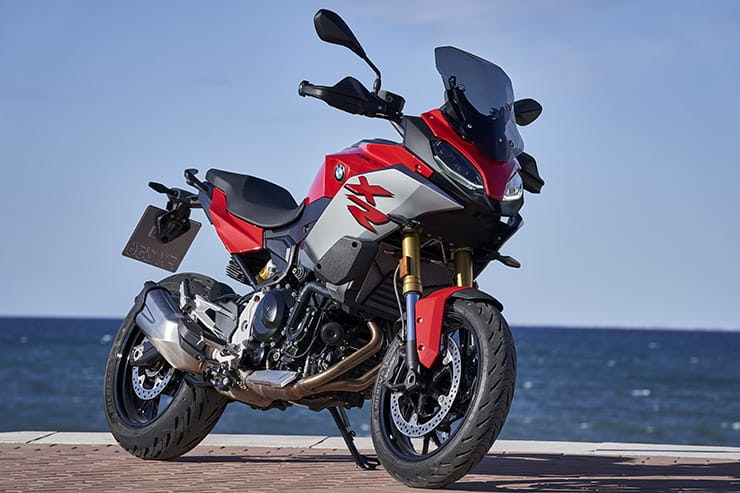BMW F900XR (2020) review
By John Milbank
Consumer Editor of Bennetts BikeSocial
23.01.2020
KIT CREDITS
Every so often you ride a motorcycle that just feels right from the moment you pull away. The BMW F900XR is one of those bikes.
The company is very open about the fact that it wants a slice of the cake that – so far – Yamaha has been pretty much hogging with the Tracer 900; the Germans hope that the F900XR will give them their chance…
2020 BMW F900XR Price
Starting at £9,825 for the base model, the F900XR isn’t much more expensive than the entry-level Tracer 900, but it’s got a few techy updates that make it feel the more up-to-date machine.
Move up to BMW’s TE model and you’ll be paying from £10,685, but you’ll be getting cornering ABS and a host of other electronic extras, as well as cruise control and heated grips. Pannier rails are included in that, but expect to pay £654 extra for a pair of hard panniers and £328 for a top-box. The £11,195 Yamaha Tracer GT comes with colour-matched hard panniers. Of course, there are various options open to you when buying any BMW, but the online configurator will show you how much the options that matter to you will cost.
While the Tracer is the obvious competitor to the BMW – it’s also got no off-road pretences – the Triumph Tiger, costing from £9,500, might also be on your list (it too has a very long option list to bolster that price). Or perhaps the Suzuki V-Strom 1050, which starts at £9,999.
They’re all in the same ball-park, but the BMW has some impressive features, and it’s also very compact and accessible to ride…
Power and torque
On paper, the BMW has some pretty impressive performance figures:
While the Yamaha has higher peak power than the BMW, it makes it 1,500rpm later in the revs. And it’s down on torque; it’s the heavier and bigger Suzuki that really stands out in this group.
Do be aware that there’s an A2 version of the F900XR, which makes a peak of 93.9bhp@8,000rpm (so that it can be legally restricted to half that for A2 licence-holders). There’s no way at all to give this version of the bike the same power as the standard machine, so watch out, especially when buying used.
Engine, gearbox and exhaust
Despite being more torquey than the MT-09, the BMW doesn’t feel it – at least at first. Where the Yamaha has a fairly immediate rush, the F900XR is very easy going; it’s not sluggish, but it makes its power very smoothly through the revs.
Until you realise that the throttle mapping is set up to deliver a real rush in the last 20% of the turn.
It’s not about where in the rev range the parallel-twin motor makes its power, it’s about where you have the throttle, which makes for a bike that’s very easy to ride every day, but gives you a real buzz when you get on the throttle.
If you want the immediacy and relative aggressive nature of the Yamaha, you might not like the way the BMW fuels. And on the F900R – the roadster that BMW is targeting at the MT-09 – despite it being exactly the same engine, it might bother more people. But on this adventure tourer, it feels just right.
It’s not all perfect; in low gears the throttle is quite choppy, cutting quite sharply when you roll right off the throttle. Yet somehow, again, it’s not as intrusive as it is on the F900R, most likely due to the way you sit on this bike, with far less weight over the front.
The motor – which like many small-capacity engines in BMWs since 2005 is made for the company by Loncin in China – is more than happy to pull the bike around tight, twisty mountain roads in third gear (at least with no luggage or pillion); it’s surprisingly easy to ride it lazily, and it certainly smooths out the throttle.
The gearbox is fine – it’s far from the slickest ’box available, but at this price point it’s certainly not the worst. Compared to my own BMW S1000XR it’s more notchy, which also means that if you’re using the optional quick-shifter and you’re not high in the revs, it can feel pretty clunky compared to more expensive transmissions. £10k is a lot of money of course, but keep in mind that, back when the ‘bargain’ Suzuki Bandit 1200 was launched in 1996, it cost the equivalent of £10,211 in today’s money.
There’s no denying that the F900XR doesn’t have the intoxicating roar and bark of its big brother (in-line four) S1000XR – nor can it compete with the triples fitted to the Yamaha or the Triumph – but it’s far from asthmatic, having a decent rumble from the Euro5-compliant exhaust system. Don’t think though that you’ll be able to pop an open end-can on to give it a bit more character – besides most modern exhausts doing all the work in the collector box slung underneath, the BMW’s collector and end-can are one piece.
2020 BMW F900XR Economy
Over 85 miles, I saw 45mpg with a mixture of very aggressive stop-start riding and a fair chunk of slow, nervous progress around a narrow mountain road – with perilous drops – in thick fog. I wouldn’t be surprised to see more out of it, but with this economy, the 15.5 litre tank would see you cover 154 miles before it ran dry. The claimed maximum of 229 miles from 67mph would take some steady riding, but I wouldn’t be surprised to easily see 180 miles.
It’s not the biggest tank, especially when you compare it to the Tracer 900 and Tracer 900 GT, which have 18 litre tanks. Gal Shaked owns a 2017 Tracer 900, and says he consistently sees 60mpg, which is a range of up to 238 mpg.
Owners of the same model as Gal’s on Fuelly.com are averaging 55.2mpg – which is a maximum range of 218 miles – but going by the EC-standard claimed fuel consumption figures given by both manufacturers, which are conducted under the same conditions (Yamaha quotes an average of 51mpg, which would give a range of 202mpg), the bikes have a similar potential. Time will tell as owners of the BMW present some real-world figures…
Handling, suspension, chassis and weight
We were riding fully-equipped TE versions of the BMW F900XR, which meant our bikes had the Dynamic Electronic Suspension Adjustment (Dynamic ESA) – a £375 option (or part of a pack), even on the TE.
The front fork is a conventional, unadjustable upside-down fork, but the rear can be upgraded to boast semi-active damping control in two modes – Road and Dynamic – as well as spring preload adjustment to one of three settings at the touch of a button. That’s a lot easier than using a C-spanner or even a remote adjuster knob, but it’s also especially valuable on the BMW as it has an excellent load capacity. While the Tracer 900 is homologated to carry only 169kg, the F900XR can safely lug up to 219kg, which matters on a bike that’s likely to carry a rider and pillion (probably around 160kg alone), as well as their luggage.
On the motorway, just like my S1000XR, the ‘Dynamic’ damping setting felt a little harsh, but tapping the button on the left switchgear twice was all it took to smooth things up with ‘Road’ mode. It never feels too soft either – a lot like the previous model S1000XR – and when things get a bit more spirited in the turns, swapping to ‘Dynamic’ makes the BMW feel more controlled and engaging.
The BMW Motorrad Connected app allows you to share pic with various data overlaid, including lean angle, acceleration and deceleration G-forces, distance, speed (if you want) and more…
The constant pull through the revs from the motor, combined with the excellent handling, makes the F900XR a hoot in bends; fast sweepers and tight mountain roads are all thoroughly enjoyable. And because this bike feels so compact, it’s not intimidating when the rain comes. Or the hail. And the fog (remind me why we went all the way to Spain for this weather?).
The tight turning circle and small form would make for a superb city bike, so it’s impressive just how versatile the little BMW can be. That compactness makes it feel light too; despite being slightly heavier than the Tracer and the Tiger, being able to get both feet flat on the floor so easily (I’m 5’10” with a 32” inside leg) makes this bike feel very manageable, even when turning around for the umpteenth photo on an off-camber wet road.
Seat heights can be a little misleading as it also depends how wide the saddle is. The F900XR really doesn’t feel tall, thanks to the narrow form that two cylinders can allow. Check for lowering options too, either through lower seats or suspension lowering kits (the F900XR for instance can go down to 775mm).
The F900XR I rode came with Michelin Road 5 GTs, though machines will come with either these or Bridgestone T30Fs – it will just depend what was fitted at the factory and there’s no choice.
2020 BMW F900XR Brakes
Despite using the same Brembo calipers with the same pads as the F900R, the riding position makes them feel a little better here. They don’t bite aggressively, but they’ll pull you up efficiently, the ABS cutting in without feeling juddery when you jam them on hard.
Cornering ABS is an option (or standard on the TE), and while I haven’t had to use it when leant over, it’s something I opt for, given the choice.
The sport dash (only available with ‘Riding Modes Pro’) gives you feedback on your braking pressure, displaying the maximum reached until you turn the engine off. You can also see the deceleration G-forces on the BMW Motorrad Connected app.
Comfort over distance and touring
Only several days in the saddle will really show the XR in its true light, but my sensitive behind found the XR a comfortable place to be – compared to the F900R, which saw me getting achy after an hour or so, the XR was comfortable for the duration.
The screen’s a little disappointing, being a bit buffety at speed when it’s in the up position. It’s very easy to switch between the two heights thanks to a lever on the right, but it’ll be most likely left in the lower position, where there’s less shaking with the wind directed full onto my head. The wind blast is just above my visor with it set high, but the buffetting could get annoying, depending on how tall you are and what lid you have.
Rider aids and extra equipment / accessories
As with any BMW, there are a host of options available. At a price…
Regardless of which model you choose, if you want the adaptive cornering headlight – which illuminates the inside of a turn, so the apex doesn’t disappear into darkness as you lean over – it’ll cost an extra £330. The up and down quick-shifter will cost £330 more, while Dynamic ESA is £375 more. Keyless ignition is an extra £240 and tyre pressure monitors are £185. There’s also a centre-stand, lowered (or raised) seat and plenty of other options, some of which are available in packs; the online configurator will give you all the choices and their prices.
It’s great to find enough space for a disc lock under the seat
There’s not a hugely obvious difference between the standard Rain and Road riding modes and the Dynamic and Dynamic Pro, but they do get a little sharper with each button press.
The mirrors give a good, wide angle of view though they do blur the image through vibration (which isn’t obtrusive through the bars, seat or pegs). There’s some space under the rear seat – which will be handy for a disc lock – and the TFT screen is clear and easy to read and navigate.
Our bikes had the optional Dynamic Traction Control, which works well in the background – after one section I looked down to find it had been activating on the wet, greasy roads, but I hadn’t realised.
The BMW Motorrad Connected app allows the dash to show speed limits and turn by turn navigation, though there’s still the option of preparation for a sat-nav; it comes with a mount for the Garmin-made BMW Navigator, though by removing this you may well be able to use it for a TomTom mount.
That app also records your whole journey (if you want), with accurate mapping displaying all of the trip for replay at up to four-time speed. At any point, you can view your acceleration and deceleration G-forces, where you activated ABS, lean angle, altitude and speed (you can disable that). You can also check out the Bike’s fuel level, service status, mileage etc. It’s by far the best bike connection app yet released by any manufacturer. And unlike some <cough>KTM<cough> Roman Vilimek, BMW’s leader of the apps development, tell me it will always remain free to download on iOS and Android.
I was using it with my Samsung Galaxy S10 and once set up it connected quickly and automatically to the bike at every start-up.
This is the headlight circuit board for the high and low-beam… those four small yellow squares in the middle are the LEDs!
The cornering headlight is potentially a good option – while we weren’t given the chance to test it in the dark, a demonstration showed that it’s very effective at spreading light in a turn. Legislation sets a maximum light output for any lamp, so there’s only so much any headlight can do (before you add extra spots), but BMW has cleverly designed the high and low beam to use a warmer colour temperature – closer to sunlight – which is easier on the eyes when trying to see at night. Conversely, the Daytime Running Light (DRL) is a cooler, bluer light that’s easier to be seen with.
Datatool’s TrakKing tracker can be fitted for free by your dealer – you just pay the subscription – which is well worth considering. For more information on trackers, click here.
BMW F900XR cornering headlight
A demonstration at the launch showed how the headlight works
I ordered one
Bennetts Facebook subscriber Paul, who lives in Portugal, owns a 2017 Triumph Street Triple RS and a 2019 Honda CB500X, but was looking to combine the two into one do-it-all bike; “The Street Triple was a bit too hard core and uncomfortable,” he told us, “while the Honda’s engine and brakes are too feeble and the suspension too basic.”
Paul with his Honda CB500X, one of the two bikes he’s trading in for an BMW F900XR
“Motorcycling is only a hobby for me, i.e. not for commuting, so my riding is mostly half-day trips out into the countryside with the occasional over-night stay.
“I wanted a more all-round bike so that this year I could do some proper touring with my wife, and so began looking for a sports tourer/adventure-style machine.
“I tried several, including the R1250GS, the Ténéré 700 and the KTM790 and, having recently changed my mind about the fabulous, but ultimately rather silly Triumph Rocket, was on the verge of signing for a Yamaha Tracer 900GT, which I rode a couple of times and really liked.
“Then I saw the BMW at EICMA and it was a bit of a no-brainer: it’s more up-to-date than the Yamaha and offers equipment – admittedly as an option – that the Tracer doesn’t; semi-adaptive suspension, lean-angle ABS, wonderful iPad-style screen, five-year warranty, keyless ignition, full connectivity, tyre pressure monitoring... Best of all, my fully specced XR was only €100 more than the Tracer GT.
“I was only able to ride 50 metres inside the dealer’s workshop, but the bike just felt so right.”
Grab handles at the back should give a firm hold for pillions
2020 BMW F900XR verdict
Riding the F900XR after the F900R on the launch came as something of a surprise; all of the UK journalists had got off the naked roadster saying how it was ‘good if’, and ‘it works but’. Yet at the first stop on the XR, we all turned to each-other and, almost in unison, exclaimed “this is brilliant!”
No motorcycle is perfect – the little XR’s engine doesn’t have the same emotive growl or throttle response of Yamaha’s triple (if that’s what you want), and the screen buffeting is annoying (which is surprising when the S1000XR screen is so good). But the F900XR is an outstanding package, offering an incredibly accessible ride whether you’re commuting, touring or exploring back roads on your own.
I wouldn’t trade my own S1000XR in for this bike, but if I didn’t already have it, I’d find it very hard to justify the extra expense, size and weight of the bigger machine over this. It’s one of the most easy-to-recommend motorcycles (to a wide range of potential buyers) that I’ve ridden in a long time…
Three things I loved about the 2020 BMW F900XR…
• High spec equipment in a relatively entry-level bike
• Confidence-inspiring handling
• Hugely versatile
Three things that I didn’t…
• Screen buffets when raised
• Electronic suspension is only on the rear
• The motor doesn’t have the character of Yamaha’s triple
2020 BMW F900XR spec
Looking for motorbike insurance? Get a quote for this bike with Bennetts motorcycle insurance
BMW F900XR vs BMW F900R honest review | Yamaha beaters?
BikeSocial takes and in-depth look at the new for 2020 BMW F900XR – which goes head to head with the Yamaha Tracer 900 – and the BMW F900R, a challenger to the Yamaha MT-09. A full and honest review of the two bikes, and which you should choose...
